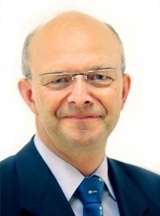Per Kjaersgaard-Andersen, MD, is an assistant professor of orthopaedic surgery at South Danish University and the head of the section for hip and knee replacement working at Vejle Hospital, which is a university-associated clinic and one of three hospitals at Lillebaelt Hospital.
The unit has a total of 11 surgeons performing about 2,000 joint, hip and knee surgeries per year and is the second largest practice in Denmark. He is heavily involved in research, especially with regard to accelerated patient treatment programs, looking at all angles of the practice.
Dr. Kjaersgaard-Andersen is part of a Danish national working group that specifically targets research on accelerated treatment programs with his esteemed colleague, Prof. Henrik Kehlet, from Copenhagen University Hospital. They are the top drivers guiding a successful initiative to reduce lengths of stay in Denmark during the past 10 to 15 years.
This article is part of our continuing series to raise awareness of the unmet needs in postoperative pain management (POPM) and to develop solutions that improve POPM across Europe. The opinions expressed in this interview are meant as an informal conversation to facilitate dialogue.
To further discuss the opinions expressed in this article, engage on Twitter, Facebook and LinkedIn #painmanagement #changepain #POPM.
More than 35 years ago, when Dr. Kjaersgaard-Andersen first began his practice, if anyone had told him that at this point in his career, the average length of stay for patients following a total hip replacement or total knee replacement would be on average 1.8 days, he would not have taken them seriously. During the 1980s, it was common practice in Denmark for a THR or TKR to require a 1-week to 2-week stay in hospital. Shortly before the turn of the century, the Danish government put out a challenge to uncover more efficiencies across all health care treatment areas, to have more patient beds in hospital, and to arrive at better overall lengths of stay to relieve the financial burden of health care on society. As a result, Dr. Kjaersgaard-Andersen sees many patients today – young, old, primary patients and others across the board — returning home on the day of surgery, while most go home the day after surgery.
United effort
The guiding principle of Danish health care is free and equal access for all citizens. As with many European health care systems – both privately and government-funded models – health is administered at local, regional and national levels. Health care professionals in all these systems will have felt pressures, either from government or from private interest groups, for example, to increase efficiencies and reduce costs, all while balancing continuous improvements in patient outcomes. This was the mandate Dr. Kjaersgaard-Andersen and working groups of Danish professionals faced when they published a survey in the Danish Medical Bulletin in 2004 that showed lengths of stay on average were about 10 days throughout the country. The primary goal at that time, driven by health care economics, was to reduce this length of stay. The result, even without it being a primary target of the initiative, was an across-the-board change to pain treatment programs. The groups found that to reduce length of stay, there were three drivers:
- Overall information to the patient about what is going on and what is expected of them;
- Information to and training for health care staff; and
- Pain treatment.
While all three drivers were essential to reducing lengths of stay, without a primary focus on pain treatment, Dr. Kjaersgaard-Andersen and his colleagues found the remainder of the drivers fall apart. “When patients are in pain, they have big problems,” he said.
He explained that early pain treatment models were focused on treatment with morphine or epidural analgesia. The benefit to epidural analgesia is it allows significant pain reduction without dependency on morphine, especially when the catheter is placed precisely. However, when a patient is catheterised, motor function is reduced, he or she is weak in the legs, and bladder function is impaired (many patients require a bladder catheter, as well). This was the early landscape, and to improve from a 10-day length of stay, on average, the Danish working groups knew they needed to implement pain management programs that could get their patients mobile.
Patient information
Dr. Kjaersgaard-Andersen describes how early in his career it was standard practice not to know a patient until the moments just preceding surgery.
“Today we are much closer to the patients prior to surgery than we were earlier. Before this, the patient was in the OR, the patient doesn’t know you, the patient doesn’t have any information. They only know they are getting a new hip or a new knee and they are anxious. All they know is they are going to have severe pain.”
Today, patients now arrive in hospital the week before surgery, often with relatives and loved ones, to get information about their procedures. They sit in groups, sometimes coming for 3- to 4-hour lectures where teams of nurses, doctors, anesthetists and physical therapists, through videos, presentations, demonstrations and tools for information sharing, teach them what they should expect. This helps patients have the confidence that everything will be all right, often reinforced by the presence of relatives, and have the knowledge prior to the surgery that they can come out on the other end knowing beforehand what to expect, and that they can overcome the challenges they may face, especially pain.
Staff training
During the 10 to 15 years in which Danish THR and TKR patients went from an average overall length of stay of 10 days to 1.8 days, the nexus between patient information and pain management and the steady reduction of time in hospital was evident. This got the attention of other Nordic countries that sought to understand how to emulate these results.
“The first thing we tell them is they simply cannot do exactly what we are doing. A copy of our program would never work for them, and each country, each group, must create their own atmosphere. If today they find themselves with an average length of stay at 8 days, they cannot expect to go home and find themselves down to 2 days tomorrow,” Dr. Kjaersgaard-Andersen said.
According to Dr. Kjaersgaard-Andersen, to build any program, the organisation must be on board with the idea. Nurses, physical therapists and patients all must be involved with the process as each department defines its culture and implements the changes necessary to bring about steady results. Together with Prof. Kehlet and the team from Copenhagen, the working groups tasked with reducing length of stay developed standard protocols whereby doctors and nurses or physical therapists and anesthetists and a variety of teams work together to understand patients’ satisfaction in much more detail. With length of stay not as the primary metric to be targeted, these teams can focus on finding individual patients who are at risk of having complications, a factor which also has an impact on hospital readmissions. Obviously, not all cases run in an exact, predictable and smooth way, but in those cases where there are issues, a dedicated nursing team takes patients’ names and understands their situations. The teams learn from these complications and study the cases through audits and discussions to determine what leads to better efficiencies.
By having steadily trained staff in these processes and building up a knowledge base within these teams and throughout the country, Dr. Kjaersgaard-Andersen said, “Patients with chronic pain become much rarer with such an efficient program. Those patients who are in some way impacted by chronic pain are recognised today as those who are at higher risk in general due to patient-specific issues that, for whichever reason during the postoperative pain period, allow that patient to trigger pain in different ways than the standard pain patient.”
This suggests that when metrics for lengths of stay are properly calibrated and staff are trained accordingly, the net effect allows for a more focused patient-specific pain management program.
“In just over 10 years, 15% of patients are going home on the day of surgery.” Dr. Kjaersgaard-Andersen said of the statistic. “I would have told you that number was impossible.”
He said this is due to a culture of pain treatment and is not a phenomenon in his department. It is apparent throughout Denmark and in places where similar initiatives have been undertaken, he said. “There are 45 units in all of Denmark doing total hip and total knee, and they all follow the same program. This is a trend, it is a culture, and it is clearly a benefit to the patient.”
What is the relationship between postoperative pain management and reduced length of stay? The answer is information and improving mobility.
When patients know their pain can be treated, they are psychologically more prepared with the capacity to support that pain. For example, in attempting to alter the program for morphine usage in the unit, it is understood there is generally always some need for morphine due to the sharpness of pain on the first day. To get patients back to full mobility, Dr. Kjaersgaard-Andersen learned that helping patients understand the impact morphine has often provides better results than just reducing use of the drug. He explains there were times when patients believe they were allergic to morphine due to past vomiting episodes and other drug interaction problems. When some explained the common impact morphine has on all patients, they better learned to work with the pain management team and support the effects, which they now understand and expect. This allowed a faster return to mobility, which is essential in returning them home.
“If you stay in bed with morphine, the saturation of your blood is reduced, there is a higher risk of infection all over the body, and in our department, we attempt to get all patients mobilised on the day of surgery or as soon as possible thereafter,” Dr. Kjaersgaard-Andersen said.
Patients are normally walking around 2 to 3 hours after surgery. While there is no demand on the part of the doctors that patients be moving, when they do move around patients score themselves lower on pain scales and present overall happier and are more motivated to get home. They are happy to participate in the program. Nurses evaluate pain, look at radiographs, analyse wound care, patient happiness, mobilisation, etc. When all the parameters are met, then the patient is happy to go home, as well. This currently happens for 15% of patients on the day of surgery across Denmark.
Readmission
The general concern would be if patients are leaving the clinical environment early, then perhaps there would be statistically greater numbers of patients returning as readmitted cases. Dr. Kjaersgaard-Andersen explains this is simply not the case:
“Would it be safer to keep all patients for a week, even if some seemed were inclined to return earlier? From our experience, the clear answer would be ‘no.’ We cannot always determine who will or who will not have a complication. Currently, we find 3% to 4% of patients present with complications that require readmission. The issues that impact these patients include urinary tract infection or other infection, a need for monitoring of a pain treatment change, or some other complication that generally occurs within the first 90 days after surgery. Even with a patient-specific focus, these 3% to 4% of patients would develop the issues they have, which would mean the other 96% of patients would simply be overtreated without any benefit to their outcome if they were required to stay longer within the unit. This would be a completely unnecessary economic burden for society.”
For Dr. Kjaersgaard-Andersen, each country and practice must determine its priorities, but in Denmark, when length of stay became the topic of conversation years ago, it changed the landscape to the point that it brought other key issues into focus and it is no longer a concern. He explains that now they are focused on other factors like patient satisfaction and mobility.
“We found early on by looking at length of stay that if you do not focus instead on pain management, the patient will never be able to do what you expect him or her to do: they would simply remain in bed and unhappy. Today, length of stay in Denmark is static, and while we will never have all patients returning home on the first day, we can still expect some improvement in this area over the next 10 years. We do not need a reduction anymore, which means our focus remains on individualised management of pain for each patient. You start in one area and you end up in another.”
Future focus
When asked what best practice he has seen develop over the years that can help other practitioners, Dr. Kjaersgaard-Andersen said it comes down to coordinated teamwork. His group found a unique change in IV steroid use, for example. By providing 125 mg steroid preoperatively (just before incision), they noticed a significant change in many of their cases, which allowed them to discontinue gabapentin use.
Currently, they are looking at research suggesting that doubling up on IV steroids (ie, one dose prior to surgery followed by another at the end of the day of the surgery or the next morning) may be enough not only to reduce inflammation in the area of surgery, but also to have another collateral effect. Since a side of effect of steroid treatment is a manic effect, patients may have a psychological boost as well that helps mobilise them in the early postoperative phase of treatment. While indications are early, and other risk factors such as risk of infection must be carefully considered, this is one area where Dr. Kjaersgaard-Andersen sees some hope of reducing chronic pain and other dependencies and to better increase the mobility which returns patients as quickly as possible to their regular function at home. Currently, monitoring of this practice in about 5,000 cases that were involved in the Danish rapid recovery program did not show any increased risk to patients.
What else might the future hold?
Dr. Kjaersgaard-Andersen said, “I would love to have new pain treatment programs with new approaches to pharmaceutical options that could maximally reduce the patient’s inflammatory response while simultaneously blocking pain receptors. If this could also provide the patient with a greater feeling of wellness with one or two drugs used in a multi-modal way, that would be the challenge I would provide to the industry.”
This, of course, is a lofty goal for the pain management industry, but having Denmark shift from an average patient length of stay of 10 to 1.8 days might also have seemed lofty 10 years ago. Today that is the reality.
It is challenges like these that bring about the best results for postoperative pain management options and patient outcomes across the board.
Further reading:
- For those looking to understand more, Dr. Kjaersgaard-Andersen recommends the following studies:
Medical dissertations:
- Husted H. Fast-track hip and knee arthroplasty: clinical and organisational aspects. Medical doctoral thesis. Copenhagen University.
- Lunn TH. High-dose glucocorticoid to improve postoperative recovery in total hip and knee arthroplasty. PhD thesis Copenhagen University. Defended April 18, 2013.
Publications in peer-reviewed journals:
- Aasvang EK, et al. Acta Anaesthesiol Scand. 2016;doi:10.1111/aas.12667.
- Glassou EN, et al. Acta Orthop. 2014;doi: 10.3109/17453674.2014.942586
- Husted H, et al. Acta Orthop. 2011;doi: 10.3109/17453674.2011.636682.
- Husted H, et al. Arch Orthop Trauma Surg. 2012;doi:10.1007/s00402-011-1396-0.
- Husted H, et al. Arch Orthop Trauma Surg. 2010;doi:10.1007/s00402-010-1131-2.
- Lunn TH, et al. Br J Anaesth. 2013;doi:10.1093/bja/aes345.
- Rytter S, et al. Knee Surg Sports Traumatol Arthrosc. 2017;doi:10.1007/s00167-014-3501-8.
- Specht K, et al. Acta Orthop. 2015;doi:10.3109/17453674.2015.1063910.
- Specht K, et al. J Clin Nurs. 2016;doi:10.1111/jocn.13121.
For more information
As the platform organisation linking Europe’s national orthopaedic associations, the European Federation of National Associations of Orthopaedics and Traumatology partners with Grünenthal to raise further awareness of the unmet needs in postoperative pain management (POPM) and to develop solutions that improve POPM across Europe.
Over the next 6 months, we will involve pain experts from across Europe in interviews, debates and other discussions to generate a better understanding of physicians’ and patients’ perspectives. The goal of this series is to communicate best practices and increase discussion on POPM in general.
Burson-Marsteller, established in 1953, is a leading global public relations and communications firm, and the EFORT-mandated press agency for the POPM awareness campaign. All articles published herein respect the third-party content policy of EFORT as published on our website.
For any articles related inquiries, please contact media@efort.org.



